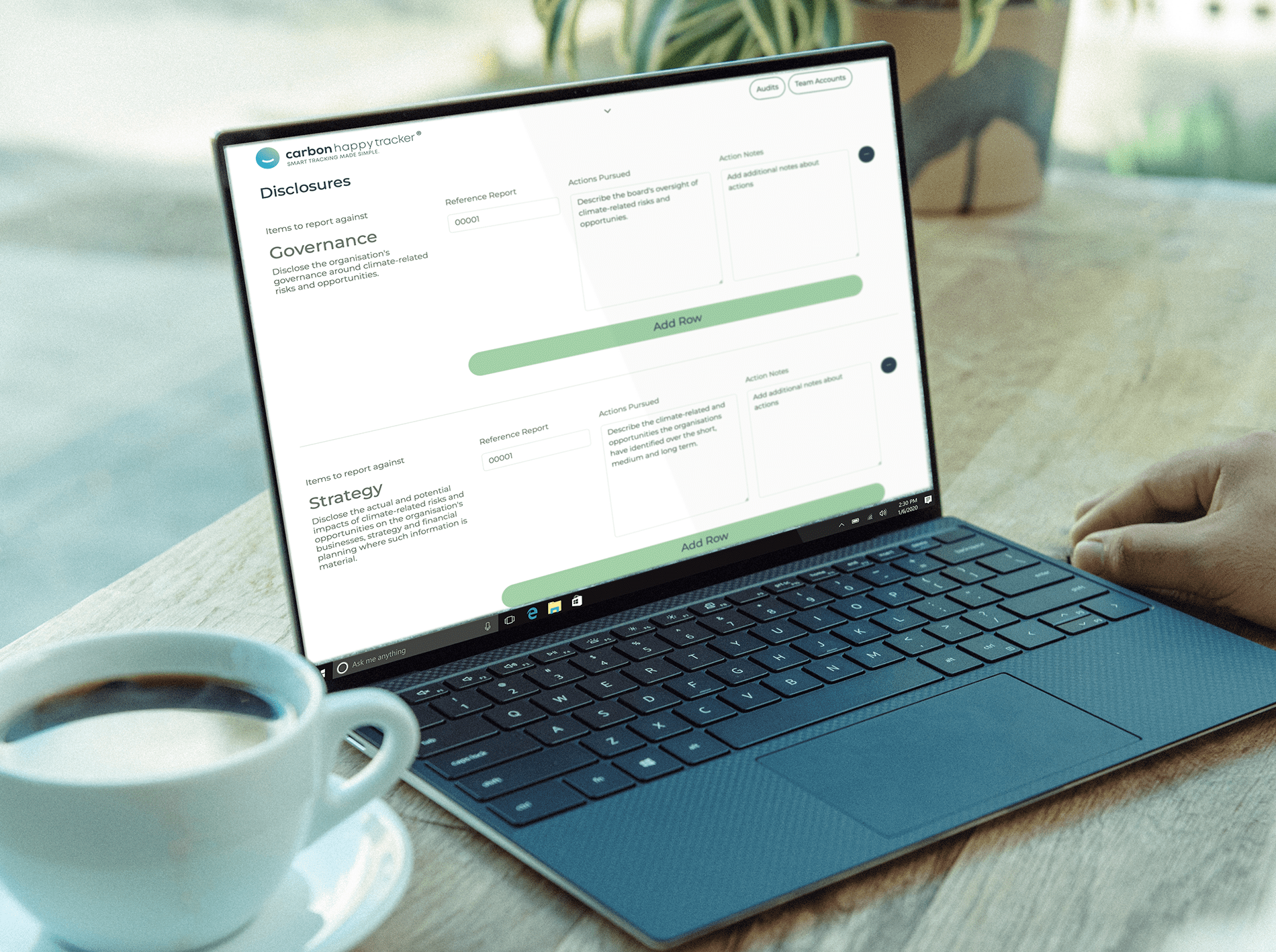September 2023
The double materiality assessment not only determines the scope of the organisation’s sustainability reporting. It also enables an efficient allocation of the resources needed to achieve CSRD compliance and provides indispensable insights for shaping company strategy.
Carbon Happy World eight-step process for the delivery of a double materiality assessment is outlined below. It shows you some of the challenges in undertaking a double materiality assessment and introduces some of its strategic implications.
“Double materiality can be confusing and can take you and your company into places you’d rather not go, so when assessing a company’s risk be careful not to over elaborate, exaggerate or ignore environmental risks.
The term ‘double materiality’ is new to most and will become more common pace over the next few years as disclosure requirements across the globe come into force, so whether it’s ISSB, CSRD, TCFD, SDS or SSE the outcome will be the same.”
Double materiality ensures that sustainability reporting focuses on the topics that are most relevant for the organisation and its stakeholders. Material topics also underpin the (sustainable) strategy. A report and strategy based on material topics create more transparency, contribute to better decision-making and ensure that time and resources are focused on those topics that matter most to both the organisation, its stakeholders and wider community.
There are a number of ways to start assessing environmental risks, here is our guide.
First it is important to note that any reporting under CSRD will be accepted in digital format only. The reasoning is to allow comparability, transparency and accountability.
- Get the Governance right. Making sure you and your team have the support from the board will give the whole reporting and disclosures process authority, accountability and authenticity. The starting process begins with understanding the big picture. Ensure your team is diverse and takes a systemic approach across the whole company.
- Communicate. The team must start by talking and listening to employees, stakeholders (customers and suppliers) and when needed the local communities where you are working. Under CSRD (corporate sustainability reporting directive) the use of stakeholder input has changed. Whereas previously stakeholders were asked which topics they considered important, now they are asked to identify the organisation’s most significant impact on people and the environment, and the most significant sustainability risks and opportunities for the organisation. This is challenging, because not all stakeholders will be able to compare and assess a broad range of ESG topics from these two perspectives.It helps therefore to do part of the assessment with internal and external experts on the various sustainability matters. That helps to gain insight into the impact of the organisation, but also ensures stakeholder dialogue can focus on what the organization can do better. Stakeholder engagement should not only be used to data and feedback for the materiality assessment, but there should also be time for discussion on the strategy, policies and action plans for these topics.
- Review sustainable risks and opportunities. Organisations will also be required to identify entity-specific sustainability matters that are not explicitly mentioned in the ESRS (European Sustainability Reporting Standards). An example is a company’s tax policy, which can have a significant impact on society, and can also be a risk and opportunity considering regulations on tax transparency and measures against tax avoidance. In a later stage, organisations will also have to consider sector-specific sustainability matters based on the sector-specific ESRS that are still in development.Organisations need to consider their sectors of activities, geographical areas of operation, as well as steps in the value chain when identifying potentially relevant sustainability matters. Previous materiality assessments, internal documentation (e.g. impact, risk and opportunity assessments), external documentation (e.g. sector reports, benchmarks and ESG ratings-UNRSID), and insights from stakeholder engagement can be used as sources of input and development.By working with internal specialists (from a governance perspective) and using internal resources (e.g. strategy documents) organisations can avoid being overwhelmed with a huge list of topics and can create an actionable short list of topics to be considered.
- Define risks and environmental opportunities. In the process of determining whether the sustainability matters as identified in the previous step are indeed material (and should therefore be disclosed in the sustainability statements), the next step is to define them – as required by the ESRS – in terms of the impacts the organisation has and the risks and opportunities they present.
The team must stay focused and within the parameters set by the board. Impacts related to any sustainability matter on people and the environment can be positive or negative, actual, or potential, and interconnected with the impacts from other topics. Impacts, risks, and opportunities can occur in the short, medium or long term and pertain to (future) events and activities across the value chain.
By using a wide range of stakeholders it’s crucial to tap into all the relevant units of an organisation in order to make these assessments as varied and deep as possible. As these assessments need to cover their entire value chain, organisations should be ready to ask for help bringing in the need topic experts, for example when it comes to biodiversity-related impacts and human rights of workers in the supply chain.
- Impact assessment. Once sustainability matters have been described in terms of impacts, risks and opportunities (step 3), the next step is to quantify those impacts (step 4) and risks and opportunities (step 5). This requires answering questions such as ‘How much damage does a certain activity cause? How many people are affected by it? What is the cost of undoing the negative impact of an activity?’
The level of detail involved in this step is on the one hand needed to apply the parameters defined in the ESRS. It also facilitates future disclosures. A granular assessment helps to later determine which disclosure requirements and data points are material. Moreover, organisations need to disclose how they manage their impacts, risks and opportunities connected to each topic. Going into detail here will clarify potential strategic implications.
Input for these quantitative assessments can be obtained from (again) engaging with stakeholders and experts, both internally and externally, through interviews, surveys, and workshops. In addition to this bottom-up approach, a holistic, top-down review of the outcomes is advised to address a critical challenge organisations face when assessing impacts: How to compare impacts that are completely different in nature? Does it make sense for example that biodiversity scores higher on impact materiality than corruption?
- Financial Materiality. This is normal practice for any business, we do this is on our daily business life, checking the financial health of your organisation. Here we add a layer of on it; environmental materiality, hence double materiality. Here we assess the financial effects that have not yet been incorporated into the financial statements. The CSRD asks organisations to look at financial effects from two perspectives: to what extent can you continue to use your current resources and to what extent can you maintain your existing relationships?
It requires an understanding of what is happening in the value chain, as well as an insight into sustainability developments that can affect business processes. For example. Will polluting activities, such as air pollution, be taxed more heavily? Will the trend for customers ask for other (more sustainable) products and services increase to an extent that your business model will have to change completely?
These risks and their likelihood will determine the financial consequences of reputational risks as a result of consumer behaviour.
The assessment of risks and opportunities requires input from a range of experts. Sustainability teams can help identify events that might trigger a risk or opportunity, e.g. new regulations, increased public scrutiny or changing stakeholder expectations regarding a certain topic. Risk experts can support and ensure alignment with the broader enterprise risk management approach. Financial experts can help to assess the magnitude of the financial effect, e.g. increase in R&D expenses, loss of revenue or increase in operational costs.
- Materiality Mapping. Once impacts, risks and opportunities have been assessed, an organisation can create separate ranked lists (high to low materiality score) for negative impacts, positive impacts, risks and opportunities. By applying a threshold or cut-off point these lists can be split in material (positive) and not material (negative) impacts, risks and opportunities.
Here, the challenge is in setting the thresholds, since the ESRS provide limited guidance on this. An organisation should include all significant impacts, risks and opportunities, but if too many are included the sustainability statements and strategy no longer focus on those topics that matter most. A dialogue with senior management and the experts involved is needed to develop a holistic view of the most material matters.
For the sustainability statements, but also for internal discussions, the outcomes of the assessment now need to be visualized. A materiality matrix is an option, but not a requirement under CSRD. The advantage is that a matrix provides an easy-to-read, consolidated overview. The downside is that some information is lost, given that assumptions are needed to consolidate and plot positive and negative impacts and risks and opportunities in a single dot in the matrix. Some organisations therefore decide to show the results in a table which includes more detail. A detailed scorecard is available on the Carbon Happy Tracker, but you can make your own as set below.
| Sustainability Topic | Impact Materiality | Financial Materiality |
| Climate change | High | High |
| Water scarcity | High | Medium |
| Waste management | Medium | Low |
| Human rights | High | Low |
| Labour practices | Medium | Low |
| Supply chain management | Low | Medium |
- Action Plan. For each sustainability matter that has been identified as material, the CSRD requires that companies disclose exactly what measures you are putting in place to manage their environmental and societal impacts. As a result, you will have to disclose not only the metrics and targets you have set for each sustainability measure, but also the policies and action plans you will execute to achieve your goals. In short:
- What do you want to achieve?
- How do you expect to do this?
- When do you expect to start?
- Have you measured your carbon footprint as accurately as possible?
- Does the plan fit with Paris 2015 and your net zero goals?
- How do other initiatives such as B Corp and SDG’s fit into this plan?
In addition, the mandatory reporting and other regulator requirements compels companies to make disclosures about how they account for sustainability matters in your strategic planning processes. This includes coverage of how material impacts, risks, and opportunities arise from and require adaptation of the business model, market position and value chain (today and in the future).
These requirements lead to an increasing need to expressly consider sustainability impacts and to take a longer-term perspective when developing corporate strategy. The disclosure of action plans also requires companies to formulate credibly how they will ensure sustainability matters are addressed in the organisation and which parts of the organisation need to be involved.
In conclusion and with specific reference to CSRD.
- Prepare and submit a CSRD report – A large company’s first CSRD report will be due in early 2025 based on the company’s 2024 fiscal year environmental performance. Small and medium enterprises (SMEs) must begin reporting for 2026 using the CSRD’s streamlined SME guidelines
- Track and disclose the required information – CSRD reports must include management commentary and data (via a dedicated management report section) on a company’s:
- Materiality process to assess material ESG themes, topics, risks, impacts, and focus areas. According to the EU Commission: “all standards and all [CSRD] disclosure requirements and data points within each standard will be subject to materiality assessment by the undertaking, with the exception of the disclosure requirements specified in the ‘General disclosures’ standard”
- Sustainability and ESG performance targets, goals, and progress (the CSRD recommends at least absolute greenhouse gas emission reduction targets for 2030 and 2050)
- The plans of the undertaking, including implementing actions and related financial and investment plans, to ensure its business model and strategy are compatible with the transition to a sustainable economy and limiting global warming to 1.5 °C in line with the UN 2015 Paris Agreement and the objective of achieving EU climate neutrality by 2050 as established in Regulation (EU) 2021/1119 of the European Parliament and of the Council
- Sustainability risks (including climate change) affecting the company, as well as the organisation’s operating impacts on society and environment
- The resilience of the undertaking’s business model and strategy in relation to risks related to sustainability matters
- How sustainability and ESG risks could or are impacting operating results and business performance
- Where relevant, the exposure of the undertaking to coal-, oil- and gas-related activities
- Environmental protection policies and actions
- Company sustainability policies
- A description of the company’s sustainability due diligence
- Social responsibility and treatment of employees
- Respect for human rights
- Anti-corruption and bribery practices
- Corporate ESG governance in relation to sustainability matters, the administrative, management and supervisory bodies’ expertise and skills in relation to fulfilling these responsibilities
- Corporate board diversity
- Important social, human, and intellectual capital
- How the undertaking’s business model and strategy take account of the interests of the undertaking’s stakeholders and of the impacts of the undertaking on sustainability matters
- Digital data and tagging – Companies must prepare their financial statements and management statement in XHTML or electronic format in accordance with the ESEF regulations and the EU sustainability taxonomy, then digitally ‘tag’ their reported sustainability information according to a digital categorisation system specified by the CSRD Regulation (or use ESG software like Brightest that can auto-tag and format data)
- Third party assurance – Organisations reporting under CSRD will also be required to seek “limited” assurance of the sustainability information they disclose from a neutral, trusted, and experienced third party who reviews the data. “Limited” assurance is less strict than a financial audit, but still requires working with an independent sustainability reporting partner organisation or auditor
Materiality assessment will have to change, for most companies. The biggest change is to start with impact on people and planet and to consider the scale or severity of risks first, before starting to think about the precise impact the company has and what it can do about it?
* European requirements don’t simply require stakeholder engagement, but identification of and consultation with affected persons – which is another big change.
* The European standards require a threshold of “more probable than not” or even up to that probability, for a sustainability issue to be material. This is quite a low threshold.
* There is a bigger problem in sustainability data being available but not being used, than there is in lack of availability or reliability of corporate sustainability information.
The key issue for auditors and regulators is not whether companies have made precisely correct calculations, but can demonstrate their process and the assumptions used.
* Capacity to implement is a challenge – with companies needing to draw on multi-disciplinary teams. Competency will become an increasing issue, not necessarily in the Board or the team directly, but ensuring access to it.
* Will low impact valuations in any one company lead to a ‘tragedy of the horizons’ where impact is still not seen to be sufficiently material?
Companies should not simply see impact as a risk to be minimised but as an opportunity to be pursued with a clear action plan to guide you.
More From The Blog

- World Clean Data Day 2024

- DTM Legal Partners with Carbon Happy World to Strengthen ESG Commitment in Liverpool City Region

- Embracing Sustainability: Your Pathway to Procurement Success

- What does the future of ESG Reporting look like?

- Carbon Happy World tell you what double materiality and ESG reporting is.

